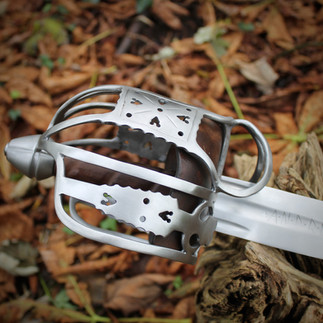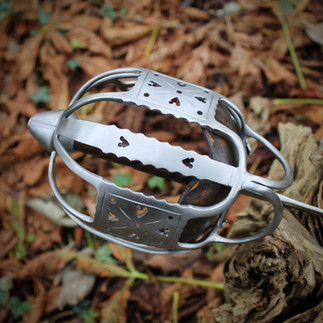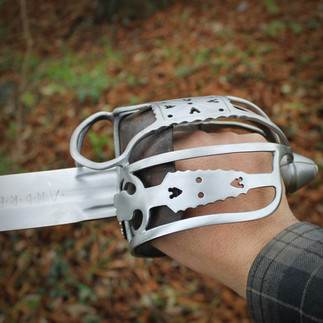The Ferrara Broadsword
- Alicia Adams

- Nov 14, 2022
- 4 min read
Updated: Apr 3, 2024

This early Scottish basket-hilted broadsword takes an amalgam of extant finds as its inspiration, with its basket adorned with hand-pierced and filed details. Built for display and reenactment rather than fencing, it features butter-knife edges. Designed for ambidextrous use, it is symmetrical in form with slight asymmetries in decor that give it a historical handmade sense. The historical decoration is laboriously cold-punched in using specially made chisels. The large internal welds on the saltires are carved to mimic the forge welds on the original baskets, adding an extra layer of authenticity. It moves with an agile balance, with a medium authority to the blade that lends itself well to the rotational movements of Highland-style fencing. It moves particularly keenly from a tip-up guard into a slicing motion, while the custom-sized basket allows for a loose, controlled grip. The name "Andrea Ferrara" is engraved into the fuller of the blade in the tradition of the sixteenth and seventeenth centuries. Initially the mark of the Italian smith Andrea de Ferrara who was brought to Scotland by James IV to instruct the Scots in the art of bladesmithing, the name soon became synonymous with any Scottish basket-hilted broadsword of great quality. Please see our pricing structure for an idea of what a similar sword would cost.
∴ Specs ∴

Total length: 96cm
Blade length: 80cm
Blade width: 4.2cm at the shoulder
Blade stock: 6mm
Quillon span: 12cm
Grip length: 11cm
Grip and pommel: 15.5cm
Grip to guard: 5.5cm
Point of balance: 7.5cm from the cross
Weight: 1360g
Ambidextrous
Butter-knife edges
∴ Notes ∴

The hand-forged and heat-treated guard basket is polished to a satin finish. It features flat bars, scalloped edges, and piercework patterns of hearts and circles. The pommel is conical with hand-carved grooves. The oak grip is carved into a spiral, and covered in dark brown kidskin. The basket contains a dark brown leather half-liner. The blade features a deep central fuller to two-thirds of the blade, with the name Andrea Ferrara engraved into it.
∴ Gallery ∴
∴ A Contested Name ∴

You push through the marketplace briskly, ignoring the calls of the merchants and the chatter of the women-folk. A high, thin sound rises above the hubbub and draws you to the place of its origin. It is the ring of hammer against steel, and a sure sign that the blacksmith is back at work.
“Where’s my sword then, you gillie-wet-foot?” you bellow as you push through the low wooden doorway. You rub your eyes against the thick, dirty smoke that fills the room, then stop in your tracks. The fellow at the anvil is not the barrel-chested blacksmith you left your blade with a month ago.
Swarthy and wiry, with curling black hair pulled back in a queue, the man is no Scot. Nor does he seem interested in your sudden appearance and demand, still consumed by his work with chisel and burin.
“Where’s the smith?” you demand.
At this, he glances up.
“I am he,” he replies, with a hint of an accent. Italian, you wager, or Spanish.
“What happened to the other fellow? Old Watt? I left my sword with him for fettling and he shut up shop with not so much as a word!”
The foreigner only shrugs before turning his attention back to the piece on the anvil.
“Look now you scurrilous beggar,” you cry, “I’m in this town on King James’s business, and I can’t very well complete that business without my sword.”
At this, the man gives you a curious look.
“I sympathise,” he pronounces, definitely Italian, “for I too was sent here by the King. However, you have twice insulted my good name, and honour demands a duel.”
He takes the broadsword from the anvil and holds it out to you. It is a thing of beauty, its basket hand-carved with lace-like piercings and scalloped edges. Dumbfounded, you can only wrap your hand around the spiralling brown grip as the slighted metalworker moves around to engage you, deftly drawing a second sword from the rack beside him.
He falls into measure, and with a stiff bow, you begin to fence. He is good, light on his feet yet authoritative in his cuts and blows. You flit back and forth across the smoke-black smithy, the sword light and reactive in your hand. You find it able to parry cut after forceful horizontal cut, but the Italian shows no sign of tiring, and you fear that your resolve will falter first.
The foreigner bears in hard, and you move to grab his basket with your off-hand. As you do so, he steps lightly to the side, voiding your grapple and taking advantage of your outreached arm to land a light, stinging cut across it. Red blossoms across the linen of your sleeve.
Your opponent steps back with another bow, satisfied by first blood. Relief floods your senses, mingling with a slight nausea.
“Good God man,” you say with a shake of your head, “If you forge anywhere near as well as you fight, then your presence here is a blessing. What was your name?”
The Italian only smiles, taking the sword from your hand and tilting the blade so that its inscription flashes red in the light of the forge.





















